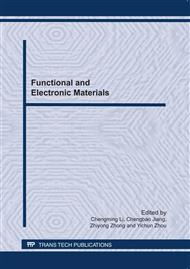p.189
p.194
p.199
p.204
p.209
p.215
p.222
p.228
p.233
The Improvement of Performance of HfO2/Gd2O3/Si Stack Compared with Gd-Doped HfO2 High-K Films
Abstract:
HfO2/Gd2O3/Si stack and Gd-doped HfO2 (GDH) High-k films have been grown on p-type Si (001) substrates by RF sputtering. The amorphous structures of GDH high k film which be grown and annealed at 700°C have been determined by HRTEM. There is a interface layer between Gd2O3 film and Si in HfO2/Gd2O3/Si stack. XPS measurement reveals that the peak shift to small binding energy for Hf4f due to the formation of Hf-O-Gd, and there are formations of gadolinium and hafnium silicate. A leakage current density of 1×10-6 A/cm2 at -1 V, a hysteresis voltage of 13 mV, a dielectric constant of 23 and a CET of 1 nm are obtained from a capacitor with Pt/HfO2/Gd2O3/Si/Ag stack through C-V and I-V measurements. In addition, the HfO2/Gd2O3/Si stack film has a higher breakdown voltage (~ 30 V) than that of GDH films.
Info:
Periodical:
Pages:
209-214
Citation:
Online since:
June 2011
Authors:
Price:
Сopyright:
© 2011 Trans Tech Publications Ltd. All Rights Reserved
Share:
Citation:


